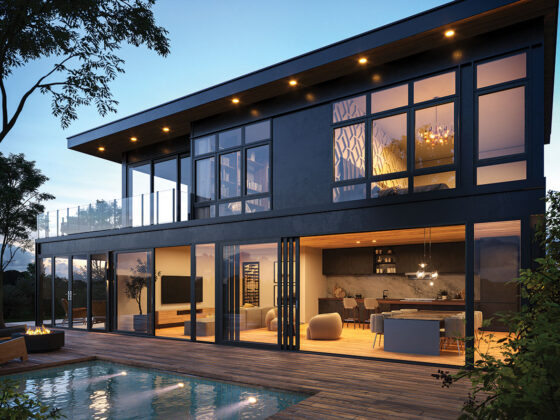
Drop zone, mudroom, hub of the home.
Story by Tracy Dickinson
Featured in May/June 2022
By their very nature, mudroom designs are oriented around family life, whatever that looks like for each homeowner. The back entry tends to become the primary access point for daily life—the pathway from home to car and back again, the drop zone for everyone’s gear, and the virtual black hole where all stray things seem to disappear.
No matter what your family’s stage of life, turning that drop zone into a command center can transform chaos into efficiency.
Roll call
One of the first considerations is the number of people using the space and how they need to use it.
“I always ask clients how many people are moving through the area each day. What are their ages? Are there pets?” says Rachel Arganbright of Woodharbor. “Can a wheelchair or walker move comfortably in this space?”
Jeanine Weinzierl of BMD/Moehl Millwork says, “The age of the homeowners and children is important to consider when creating the design. How many children and what ages are they? How will their needs change over the next few years? Are there multiple children who are active in sports or just working adults with laptops and work items?”
If the space will serve as an entry for guests, that creates other needs to be considered.
Duty roster
How the space will be used is just as important as who will be using the space.
“There really is no right or wrong way to use this space,” says Deb Pudenz of AIM Kitchen & Bath. “It’s important to know how many people you are accommodating and what items are going to be dropped there. Are there specific needs? Do they want everything tucked behind closed doors? Do they need to incorporate lower storage so it’s easier for children to reach?”
BLC Projects’ Rob Walker says, “With new construction, you have a clean slate. With remodels, we want to start with what the homeowners have now and what’s lacking in their current space.”
He says taking that wish list, along with the available square footage, provides a framework to bridge that gap. “You have to build to what’s there within the square footage available, but understanding the homeowner’s needs makes it possible to prioritize features and adjust expectations to fit the space.”
With multiple users and a variety of needs, organization is a priority. Beyond the standard coat and shoe storage, homeowners are looking for a space that suits the changing needs of their family.
“We’re incorporating everything from pet areas and wash stations to mini fridges and lockers. And having a dedicated spot for keys, shoes, and coats can range from benches and shelving to baskets or hooks depending on the space.”
Rachel Arganbright, Woodharbor
“We’re incorporating everything from pet areas and wash stations to mini fridges and lockers,” says Arganbright. “And having a dedicated spot for keys, shoes, and coats can range from benches and shelving to baskets or hooks depending on the space.”
Weinzierl agrees. “Even a small space can usually accommodate a built-in bench and coat hooks,” she says. “This area is also a great place to plan storage for larger household cleaning items like brooms and vacuum cleaners or a place for dog food storage or even a pet bathing area.”
Much of the task storage design is dependent on the square footage available, but Pudenz says that doesn’t have to limit functionality. “A home’s main drop zone is typically off the garage or whichever entrance the family uses daily. Creating a space where you can group like items and drop the most frequently used items will make everything feel and look more organized,” she says. That can be as simple as baskets or trays for keys and devices or as elaborate as custom storage for sports equipment, off-season clothing, and pet supplies.
Command central
The drop zone is more than just the traffic hub for the average family or a dumping ground for coats and backpacks. Today a truly functional drop zone also requires designing with technology in mind.
“In some ways, that doesn’t have to mean anything more than considering electrical needs and accessibility,” says Walker. “But because most drop zones are high-traffic areas, you do want to think about visibility and exposure to dirt and moisture. Having the ability to enclose charging stations and device storage is always helpful.”
Pudenz says, “Charging stations can be as simple as a countertop zone or a custom cabinet to hold tablets, phones, and other devices. But even something as small as adding USB outlets allows you to create a space for devices without giving up storage or outlet space.”
“A drop zone for phones and electronics is a must,” agrees Arganbright. “USB outlets can even be added to drawers to keep things functional but hidden.”
“Typically the mudroom was just a place for backpacks and shoes,” says Weinzierl. “But more homeowners are incorporating technology by designing a place for USB and charger stations so they can plug in and recharge their electronic devices, as well as keep them in a convenient location.”
Using this space as something of a home command center also demands appropriate lighting.
According to Arganbright, “Drop zones should be bright. If you can do it, natural light in any room is wonderful, but recessed LED lighting has come a long way from the bulky fixtures in the ceiling. Incorporating lighting controlled by a motion sensor is also really convenient so that there’s no problem if you’re coming in with your arms full of groceries.”
Walker says he expects manufacturers will continue to incorporate technology into home product design in innovative ways. “I anticipate the potential, eventually, to have charging stations built right into the cabinetry. Already, wireless systems in homes are making it possible to simply redo outlets with USB ports. Before long, we won’t even have to do that.”
Mission accomplished
Ideally, drop zones should be incorporated throughout the home, whether it’s a bowl for keys by the front door, a charging station in the kitchen, or a complete organization system in the back entry.
Arganbright advises, “Take your time planning the space. Think through your needs, but have fun with it. It’s the first space you see when you come home.”
Designing your home’s primary family entry for your needs today and for what you anticipate for the future will not only save you time and money, it will set your mind at ease.
Nothing says “mission accomplished” like a well-ordered command center. •
Resources
- Deb Pudenz AIM Kitchen & Bath
- Jeanine Weinzierl BMD/Moehl Millwork
- BLC Projects Rob Walker
- Rachel Arganbright Woodharbor








